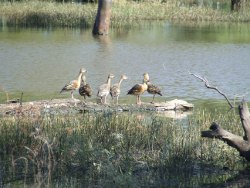|
|
Wetland ecologyEcology is the study of interactions between organisms and their environment[3][4]. An Ecosystem is a dynamic complex of plant, animal and micro-organism communities and their nonliving environment (components, i.e. matter) interacting as a functioning unit (through processes and cycles involving energy)[5]. Wetlands are among the most productive ecosystems in the world—comparable to rainforests. While covering only 6% of the Earth's surface (approximately 4.5% of Queensland), wetlands provide a disproportionately high number of ecosystem services that benefit, sustain and support the environmental, social and economic well-being of people. There are many types of wetlands ranging from rivers, swamps and lakes to estuaries and even coral reefs that also support a whole variety of different wetland plants and animals.
Quick facts
How wetlands function (processes) Wetland (aquatic ecosystem) types  Understanding ecosystems and wetlandsWetlands are dynamic systems that influence and are influenced by a complex range of environmental factors. To understand wetlands it is important to understand the broader context of the systems in which they exist, including the surrounding landscape or seascape. Wetlands are also affected by various processes such as climatic, hydrological, geological, biological and human (anthropogenic) influences. Understanding how the components (parts) and processes work at various different scales provides the key to understanding wetland ecology, and is critical to managing these ecosystems and protecting the large number of ecosystem services that benefit, sustain and support the environment, and the wellbeing of people. Cycles, Spheres, Energy and ConnectivityHow the earth functions can be thought of as a series of sub-systems that interact (spheres). Spheres are broad systems or categories that group similar components, processes and cycles. Wetlands are comprised of components of all of these spheres, which interact and interconnect through wetland processes and cycles. Energy is present in the landscape in many forms and drives ecological processes and cycles.[7]. Temporal and Spatial aspects of EcosystemsA wetland (or ecosystem) is not an isolated entity. Components and processes that support life in wetlands are not static, varying hierarchically across space and time. Maps are a way to spatially model or represent the extent of a wetland at a particular time and conceptual models explain processes and variability in wetlands over time. Wetland components are embedded within a landscape, catchment or seascape context, which is then located in a regional context such as the vast network of structures that make up the Great Barrier Reef. Wetland mapping of palustrine, lacustrine, riverine and estuarine and marine (intertidal and subtidal) systems are available based on their biophysical characteristics (see What are wetlands page). Wetland processes vary over time ranging from the microscopic (e.g. biogeochemical processes), to catchment scales (e.g. runoff, flooding) or seascape scale (e.g. tides and currents) to regional climatic and rainfall patterns. This hierarchy of spatial scales is visualised on the Hydrology page. Timing can be critical for ecosystem function. For wetland processes to occur, the components and processes depend on correctly timed events. For example, water regime of a wetlands has a major impact on it's ecology. Knowing and understanding wetland types, derived from the interaction of components and processes, assists in the management, rehabilitation and protection of wetlands. DriversIn very basic terms a driver is something that causes a process to start. Drivers can be a component or process that causes a change in an organism, community, ecosystem, or other component or process (e.g. the universe, catchment, landscape, wetland to an organism). So a driver (e.g. fire, rain or development) causes a process (e.g. fluvial or chemical) to impact on a component (e.g. soil, geology, water, air). Drivers can be natural or anthropogenic. Natural drivers include processes involving changes in energy and matter (e.g. fire, water flows / flooding). Anthropogenic drivers are human activities that modify how components and processes interact and interconnect (including how matter and energy flows). The list of drivers can vary depending on the scale or the topic being addressed. Many assessments focus on human related drivers to determine potential pressures on values and services, such as the State of the Environment Reporting (Drivers-Pressures-State-Impacts-Response framework). Drivers may include
ComponentsThe various parts of a wetland are called components. Ecosystem components include the physical, chemical and biological parts that make up the environment. Examples include the water within a wetland, the chemicals within that water, the vegetation types at a wetland, the organisms that live in a wetland, or the wetland itself (adapted from[8][9][1]). ProcessesEnvironmental processes include the ecological, physical and chemical processes that help form, maintain and support a system. Ecological processes include all those processes that occur between organisms and within and between populations and communities, including interactions with the non-living environment that result in existing ecosystems and bring about changes in ecosystems over time (adapted from[9][2]). Wetland (aquatic ecosystem types)Wetlands in Queensland have been classified into wetland systems (lacustrine, palustrine, riverine, estuarine, marine and subterranean) and discrete wetland habitat types on a state scale. Wetland types are formed as a result of the combination of different components and interactions with processes. Pages under this sectionReferences
Last updated: 9 October 2023 This page should be cited as: Department of Environment, Science and Innovation, Queensland (2023) Wetland ecology, WetlandInfo website, accessed 18 March 2024. Available at: https://wetlandinfo.des.qld.gov.au/wetlands/ecology/ |

 — Department of Environment, Science and Innovation
— Department of Environment, Science and Innovation


